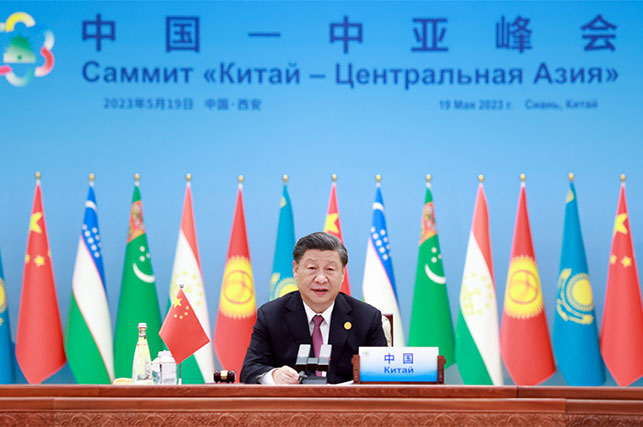
From Xi’an to Astana: Elevating China–Central Asia Cooperation to a New Height
From Xi’an to Astana: Elevating China–Central Asia Cooperation to a New Height
Tashkent, Uzbekistan (UzDaily.com) — As the summer breeze carries the scent of pomegranate blossoms across the Syr Darya and moonlight bathes the minarets of Samarkand, Central Asia once again takes center stage in regional diplomacy—with Astana hosting the Second China–Central Asia Summit from 16 to 18 June. Chinese President Xi Jinping will visit Kazakhstan to attend this event, which carries both symbolic weight and strategic substance.
This year’s summit marks more than a diplomatic gathering—it signifies the maturing of a young but increasingly impactful multilateral framework born from centuries-old ties. From the ancient Silk Road to today’s modern infrastructure corridors, the five Central Asian nations and China are deepening a relationship rooted in trust, driven by mutual benefit, and destined to shape the region’s collective future.
Ancient Friendship, Strategic Renewal
More than 2,100 years ago, Chinese envoy Zhang Qian opened the first pathway to Central Asia, laying the groundwork for millennia of exchange. In 2013, standing in Kazakhstan, President Xi unveiled the "Silk Road Economic Belt," the founding vision of what would become the Belt and Road Initiative (BRI), reviving the spirit of the ancient Silk Road for a new era. Since then, cooperation between China and Central Asia has grown from historical affinity into full-spectrum partnership.
Over the past decade, this partnership has reached “three completions”: the full establishment of comprehensive strategic partnerships between China and all five Central Asian countries, full coverage of BRI cooperation documents, and full alignment with the concept of a shared future for humanity. These milestones demonstrate not just diplomatic intent, but a shared strategic outlook that has withstood global uncertainties.
As Xi noted, the decision to deepen China–Central Asia cooperation is not a product of convenience, but a generational choice made by leaders with long-term vision, responding to the will of their peoples and the imperatives of regional stability.
Tangible Results: A Shared Path to Modernization
Since the launch of the China–Central Asia mechanism in 2020, progress has accelerated. The elevation of this platform to the leaders’ level in 2023 during the Xi’an Summit underscored its growing relevance. From the “Xi’an Declaration” to the establishment of a permanent secretariat, institutional foundations are now firmly in place.
More importantly, the mechanism is delivering real results. Trade between China and the five Central Asian states reached a record $94.8 billion in 2024, a $5.4 billion increase from the previous year. New cooperation structures in transport, agriculture, customs, and emergency management are enabling efficient multilateral coordination.
A flagship example is the China–Kyrgyzstan–Uzbekistan railway, now under active construction, marking a milestone in physical connectivity. This long-anticipated project, personally championed by the three heads of state, will reshape regional logistics and unlock new trade routes across Eurasia.
Beyond rail, in emerging sectors, Uzbekistan is advancing with Chinese investment and technology in wind power and solar energy projects, while jointly developing the “Information Technology Industrial Park” alongside firms like Huawei’s Central Asia cloud center—signaling a new chapter in the digital economy. This initiative is expected to lay a strong foundation for the exchange of innovative technologies and the production of high-value-added products.
People-to-People Connectivity: Cultural and Educational Bridges
In parallel with trade and transport, China and Central Asia are expanding cultural ties. On May 31, a China–Central Asia international tourism train—its carriages decorated with Xi’an landmarks—arrived in Almaty, launching a new chapter of people-to-people exchange.
Visa-free travel agreements, mutual tourism years, and growing educational ties are bringing communities closer. According to official data from the Embassy of Uzbekistan in China, 180,000 Chinese citizens visited Uzbekistan in 2024. To support this rising demand, air connectivity continues to strengthen, with 58 direct flights per week currently operating between the two countries—building a fast-growing “air corridor” linking China and Uzbekistan.
Educational collaboration has flourished with the establishment of the “Luban Workshops” vocational centers in Uzbekistan, training talents in e-commerce, logistics, and energy management. The growing popularity of the Confucius Institutes and a 20% annual increase in Uzbek students studying in China highlight a rising cultural affinity.
Joint heritage initiatives—such as the restoration of Uzbekistan’s ancient city of Khiva and the collaborative preservation of the Kyrgyz epic Manas—reflect a shared commitment to protecting cultural legacies and fostering civilizational dialogue.
Astana Summit: Steadying the Region in an Uncertain World
The Second China–Central Asia Summit arrives at a moment when the international system is under strain, and regions are seeking anchors of stability. Amid rising geopolitical tensions, economic shocks, and cultural divides, the China–Central Asia relationship offers something rare: consistency, mutual benefit, and a future-oriented outlook.
From Xi’an to Astana, the road is not just physical—it is a roadmap of shared development, mutual respect, and collective aspiration. As China and Central Asia enter this new phase, the Astana summit will serve not only as a diplomatic milestone but as a signal to the world: that in the heart of Eurasia, a region is rising—not in opposition to others, but in cooperation with itself.
As the wind from Chang’an whispers over the Syr Darya, and the moonlight of Samarkand illuminates the East—this is not a mere echo of history, but the prologue of a shared future.
By Anna Ge
Host and Commentator of CGTN